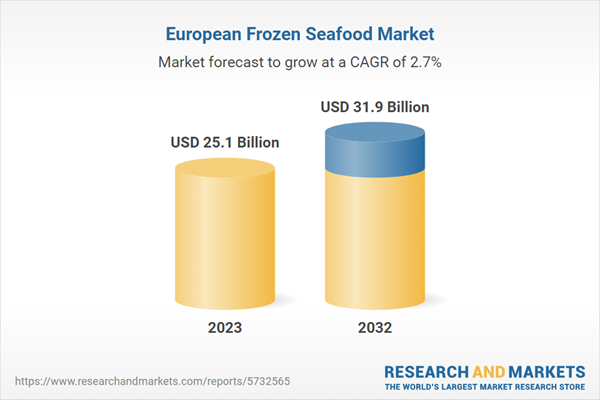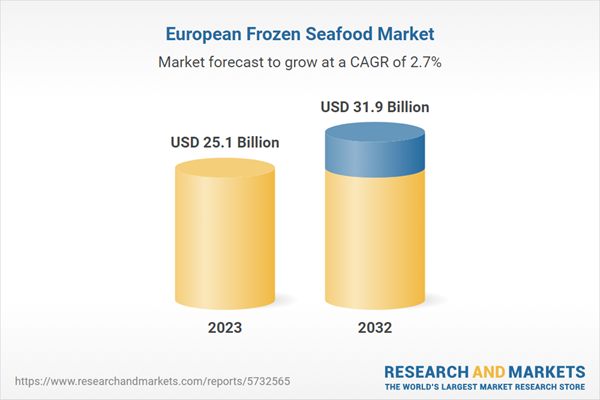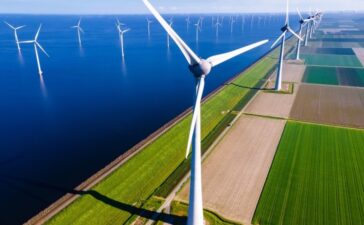
European Frozen Seafood Market


Dublin, March 08, 2024 (GLOBE NEWSWIRE) — The “European Frozen Seafood Market Report by Product Type, Distribution Channel, and Country 2024-2032” report has been added to ResearchAndMarkets.com’s offering.
The European frozen seafood market size reached US$ 25.1 billion in 2023 and is projected to reach US$ 31.9 billion by 2032, exhibiting a growth rate (CAGR) of 2.7% during 2023-2032
The nutritional benefits associated with the consumption of frozen seafood, convenience and accessibility, extended shelf life, improved freezing technologies to ensure that frozen seafood retains its freshness, texture, and flavor,, are among the key factors driving the market growth.


Frozen seafood offers consumers the convenience of having a wide range of seafood options available year-round, regardless of the species’ seasonal availability. This factor is especially appealing in regions where access to fresh seafood is limited. Additionally, the freezing process effectively preserves the quality, taste, and nutritional content of seafood, extending its shelf life and reducing the risk of spoilage.
This appeals to consumers who wish to minimize food waste and maintain a longer-term supply of seafood. Other than this, frozen seafood is a rich source of essential nutrients, including Omega-3 fatty acids, proteins, and vitamins. Health-conscious consumers value these nutritional benefits, which contribute to heart health, brain function, and overall well-being. Besides this, frozen seafood can be used in a variety of culinary creations, ranging from quick and easy meals to elaborate dishes. This versatility appeals to both home cooks and professional chefs, driving demand across different market segments.
In line with this, European consumers have access to a wide range of frozen seafood options from various parts of the world. This global supply chain ensures a diverse selection of seafood species and products, catering to diverse tastes and preferences. Furthermore, as environmental concerns grow, consumers are seeking sustainably sourced seafood. The frozen seafood industry responds by adopting sustainable fishing practices and certifications, appealing to ethically conscious consumers. Moreover, advancements in freezing techniques, such as rapid freezing methods like blast freezing, ensure that frozen seafood retains its freshness, texture, and flavor, losely resembling that of fresh seafood.
Extensive cost line and rich maritime heritage of Spain have facilitated a robust seafood industry. Spanish companies are known for their diverse offerings, including frozen fish, shellfish, and value-added seafood products. With a blend of traditional expertise and modern processing techniques, Spain continues to be a key supplier of frozen seafood products across Europe.
European Frozen Seafood Market Trends/Drivers
Extended Shelf Life
By undergoing rapid freezing processes, seafood’s freshness is locked in, ensuring that it remains in an optimal condition for an extended period. This aspect is especially beneficial for households, restaurants, and food service establishments that require a consistent supply of seafood without frequent trips to the market. The extended shelf life reduces the need for frequent restocking and enables consumers to enjoy high-quality seafood at their convenience. This aspect not only adds convenience but also contributes to cost savings and sustainability efforts.
Improved Freezing Technologies
Rapid freezing methods, such as blast freezing, freeze seafood at ultra-low temperatures quickly. This minimizes the formation of large ice crystals that can compromise the texture and integrity of the seafood. As a result, frozen seafood closely resembles the taste, texture, and nutritional content of fresh seafood. The improved freezing technologies contribute to the overall appeal of frozen seafood, as consumers can enjoy a culinary experience that is remarkably close to that of freshly caught seafood. This technological progress has elevated frozen seafood from being a mere convenience option to a viable alternative that maintains the essence of the ocean’s bounty.
Competitive Landscape
Leading companies have prioritized responsible fishing practices and sustainable sourcing. They collaborate with fisheries and organizations to ensure that the seafood they offer is harvested in an environmentally friendly and ethically responsible manner. This commitment to sustainability resonates with conscious consumers and supports the long-term health of marine ecosystems.
Additionally, key players continually expand their product portfolios to include a wide range of frozen seafood options. They introduce value-added products, such as ready-to-cook kits, pre-seasoned fillets, and innovative seafood combinations, catering to consumers’ demand for convenience and culinary exploration.
Other than this, these companies invest in stringent quality control processes to maintain the highest standards for frozen seafood. Rigorous testing and quality checks ensure that products retain their freshness, taste, and nutritional value, establishing trust with consumers. Besides this, market leaders leverage cutting-edge freezing and packaging technologies to enhance the quality of frozen seafood. Innovations like rapid freezing methods and advanced packaging materials help preserve seafood’s texture and flavor, closely resembling that of fresh catches.
Key Questions Answered in This Report
-
What was the size of the European frozen seafood market in 2023?
-
What is the expected growth rate of the European frozen seafood market during 2024-2032?
-
What are the key factors driving the European frozen seafood market?
-
What has been the impact of COVID-19 on the European frozen seafood market?
-
What is the breakup of the European frozen seafood market based on the product type?
-
What is the breakup of the European frozen seafood market based on the distribution channel?
-
What are the key regions in the European frozen seafood market?
Key Attributes:
|
Report Attribute |
Details |
|
No. of Pages |
137 |
|
Forecast Period |
2023 – 2032 |
|
Estimated Market Value (USD) in 2023 |
$25.1 Billion |
|
Forecasted Market Value (USD) by 2032 |
$31.9 Billion |
|
Compound Annual Growth Rate |
2.7% |
|
Regions Covered |
Europe |
European Frozen Seafood Industry Segmentation:
Breakup by Product Type:
-
Groundfish
-
Small Pelagics
-
Tuna and Tuna like Species
-
Salmonids
-
Bivalves and Other Molluscs, and Aquatic Invertebrates
-
Crustaceans
-
Other Marine Fish
-
Cephalapods
-
Freshwater Fish
-
Others
Breakup by Distribution Channel:
Breakup by Country:
-
Poland
-
Spain
-
Italy
-
Portugal
-
Germany
-
United Kingdom
-
France
-
Others
For more information about this report visit https://www.researchandmarkets.com/r/931c9s
About ResearchAndMarkets.com
ResearchAndMarkets.com is the world’s leading source for international market research reports and market data. We provide you with the latest data on international and regional markets, key industries, the top companies, new products and the latest trends.
Attachment
CONTACT: CONTACT: ResearchAndMarkets.com Laura Wood,Senior Press Manager [email protected] For E.S.T Office Hours Call 1-917-300-0470 For U.S./ CAN Toll Free Call 1-800-526-8630 For GMT Office Hours Call +353-1-416-8900


















